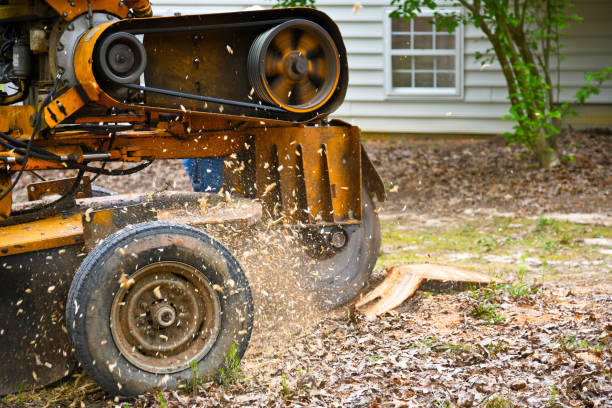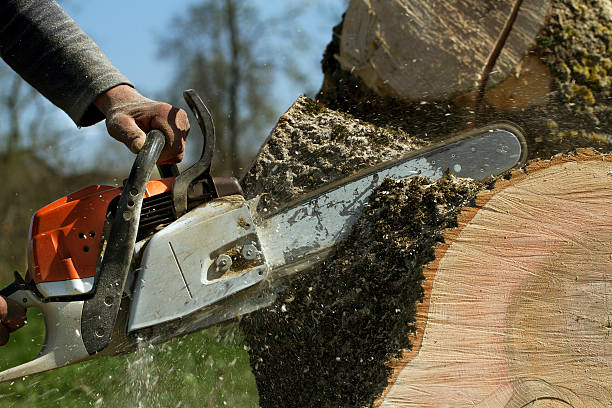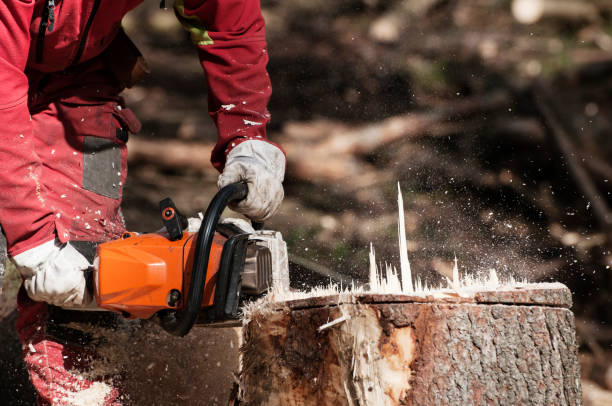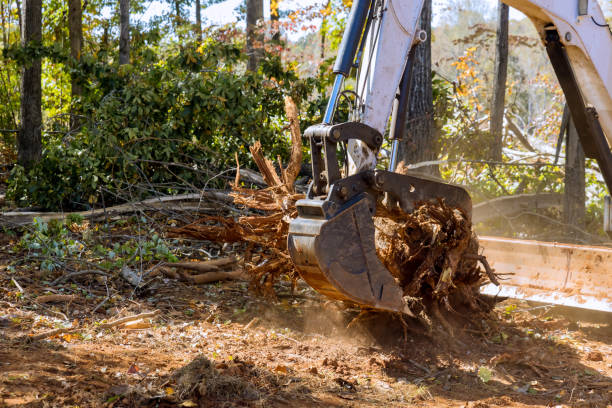
Tree stumps left behind after tree removal can pose significant challenges to your property. Not only do they detract from the overall aesthetics, but they can also create safety hazards, attract pests, and hinder landscaping efforts. Stump grinding is an effective solution to remove these obstacles while preserving the surrounding environment.
Understanding Stump Grinding with a Tree Cutting Service in Akron OH
Stump grinding is the process of mechanically removing a tree stump using specialized equipment called a stump grinder. The machine grinds the stump down into small wood chips or mulch, making it easier to dispose of or repurpose for landscaping purposes.
Unlike manual removal methods that involve digging or uprooting, stump grinding focuses on breaking the stump into smaller pieces without disturbing the surrounding soil. This method ensures minimal impact on your property while achieving a clean and polished appearance.
Why Choose Stump Grinding Over Other Methods?
- Efficiency: Stump grinding is faster compared to waiting for chemicals to decompose the wood over weeks or months.
- Environmentally Friendly: Unlike burning or chemical treatments, this method leaves no harmful residue on your property.
- Minimal Disturbance: There’s no need for large-scale excavation that could damage nearby landscaping.
- Cost-Effective: It’s often more affordable than full stump excavation.
Tools and Equipment Used in Stump Grinding
The effectiveness of stump grinding heavily depends on the equipment used.
| Equipment | Description |
| Stump Grinder | A machine equipped with a rotating blade that chips away at wood stumps. |
| Safety Gear | Includes gloves, helmets, goggles, and ear protection for safe operation. |
| Mulch Collector | For gathering wood chips generated during the process. |
Commercial-grade grinders are typically used by professionals due to their power and efficiency. However, smaller models can be rented for DIY applications.
Steps To Safely And Efficiently Grind a Tree Stump
- Clear any debris such as rocks, branches, or plants around the stump.
- Inspect for underground utilities before beginning work.
- Ensure that all safety gear is worn by anyone operating or standing near equipment.
- Check that the grinder is in good working condition.
- Lower it gradually while moving side-to-side across its surface.
- Use a rake to collect wood chips and any leftover debris.
- Fill in any remaining holes with topsoil if necessary.
Safety Tips During Stump Grinding
- Keep children and pets away from work areas at all times.
- Follow manufacturer guidelines when operating machinery.
- Avoid working near flammable materials if sparks are produced by friction between metal parts.
Regular maintenance of your equipment also ensures smoother operation while reducing risks associated with malfunctions.
Benefits Of Removing Tree Stumps
- Improved curb appeal by creating an open space free from obstructions.
- Reduced risk of accidents caused by tripping hazards left behind by stumps.
- Prevention against termite infestations often attracted toward decaying wood.
- Increased land usability allowing you freedom over landscaping design choices such as gardens lawns patios etc
Efficiently tackling these unsightly remnants makes lasting improvements both visually functionally enhancing value overall
Improve Your Landscape with Expert Tree Pruning Akron OH Services
Tree stumps can be more than just an eyesore—they can pose safety hazards, attract pests, and hinder landscaping efforts. Here’s why hiring professional stump grinding services is a smart investment and how it can enhance your property.
Benefits of Professional Stump Grinding Services
- Improved Curb Appeal
- Increased Safety
Tree stumps are potential trip hazards for children, pets, and visitors. By eliminating them through professional stump grinding, you reduce the risk of accidents on your property. - Pest Prevention
Stump grinding removes this gateway for infestations. - Reclaiming Usable Space
Grinding the stump opens up opportunities to maximize this space. - Promotes Healthy Landscaping
Tree stumps left behind after tree removal can create obstacles to mowing or maintaining a lawn properly.
Key Reasons to Choose Professionals Over DIY
- Access to Advanced Equipment:Professionals use industrial-grade stump grinders designed specifically for efficient removal without damaging surrounding landscaping.
- Expert Knowledge:An experienced team knows how to handle various types of tree stumps (e. g. , hardwood vs softwood), adapting techniques based on soil conditions or proximity to structures.
- Time-Saving:What might take hours—or even days—if done manually with hand tools can usually be completed by professionals in just one visit.
- Safety Assurance:Operating heavy machinery like stump grinders comes with risks if not handled properly; trained professionals have the skills needed to avoid accidents or damage.
| Step | Description |
| Site Evaluation | The team assesses the size and condition of the stump as well as its location relative to structures or utilities. |
| Preparation | Any obstacles near the area (such as rocks or debris) are cleared before beginning work. |
| Stump Grinding | Using specialized equipment, the grinder shreds the wood into small chips until it is reduced below ground level (typically 4–6 inches). |
| Cleanup | After grinding is complete, professionals remove debris upon request or leave wood chips behind if desired for mulch purposes. |
Why Investing in Professional Services Is Worth It
While DIY methods may appear cost-effective initially (e. g. , renting equipment), they often involve hidden expenses such as tool rentals exceeding expectations or unintentional damage caused during removal efforts.
How to Choose the Right Stump Grinding Service for Your Needs
Selecting the right stump grinding service is essential to ensure a safe, efficient, and professional job. With multiple service providers available, it can feel overwhelming to determine which company will meet your expectations.
Assess Their Experience and Expertise
- Years in Business: Companies with years of experience are often more reliable and have a proven track record.
- Knowledge of Equipment: Ensure the service uses modern stump grinding equipment that can handle stumps of varying sizes and types.
- Trained Professionals: Verify that their technicians are skilled in operating machinery safely and effectively.
Verify Licensing and Insurance
Hiring a licensed and insured company is critical. This ensures: – Compliance with local regulations. – Protection against liability if any damage or accidents occur during the job.
Read Reviews and Testimonials
Reviews from past customers provide valuable insights into the company’s reputation. Look for: – Positive feedback about their professionalism, timeliness, and results. – Responses to negative reviews to gauge their customer service approach.
Request Multiple Quotes
Cost is an important factor when hiring any service. To ensure you get value for your money: 1. Contact at least 2–3 companies for detailed quotes. 2. Compare rates while considering other factors like quality of work and additional services offered (e. g. , debris removal). 3. Avoid choosing solely based on price; prioritize quality over cost alone.
| Company Name | Years of Experience | Licensed & Insured | Quote Provided | Customer Rating |
| Company A | 10+ years | Yes | $300 | 4.8/5 |
| Company B | 5 years | Yes | $250 | 4.2/5 |
| Company C | 15 years | Yes | $350 | 4.9/5 |
Check Availability and Timeliness
Some companies may be booked weeks in advance, while others offer faster turnaround times. Ensure that: – The company can accommodate your schedule. – They commit to clear timelines for project completion.
Understand Their Cleanup Policy
Leaving wood chips or debris behind after stump grinding can be inconvenient for property owners. Ask whether cleanup services are included in the pricing or if this involves an added charge.
Ask About Additional Services
Some providers offer related services such as: – Tree removal before grinding. – Root system clearing if roots are invasive or hazardous. – Soil filling where the stump was removed, preparing it for replanting or landscaping.
Benefits of Choosing a Professional Service
Opting for professional stump grinding ensures: 1.Safety: Professionals reduce risks posed by heavy equipment operation near structures or utilities. 2.Efficiency: Specialized machinery completes the task faster than DIY alternatives. 3.Expertise: Professionals assess underlying root systems to prevent future regrowth issues.
Taking these considerations into account will help you find a reliable stump grinding service tailored to your needs while ensuring excellent results tailored specifically to your property requirements.
DIY vs. Professional
When it comes to removing tree stumps, homeowners often face the decision of whether to tackle the task themselves or hire a professional stump grinding service. Both options have their advantages and drawbacks, and understanding these can help you make an informed decision that aligns with your budget, skills, and specific property needs.
DIY Stump Grinding
Opting for a DIY approach can seem appealing for those looking to save money. However, this method requires careful planning and consideration of the equipment, time commitment, and risks involved.
Pros of DIY Stump Grinding:
– Cost Savings:Renting a stump grinder is typically less expensive than hiring a professional service.Flexibility:You can work at your own pace without being tied to another company’s schedule.Satisfaction:Completing the task yourself can provide a sense of accomplishment.
Cons of DIY Stump Grinding:
– Equipment Rental Costs:While renting may be cheaper upfront, costs can add up if you need the equipment for multiple days.
– Steep Learning Curve:Operating a stump grinder safely requires knowledge and experience that many homeowners may lack.
– Physical Strain:The process is labor-intensive and could lead to injury if not done properly.
– Limited Results:Without professional expertise, there’s a higher chance of leaving parts of the root system intact or causing damage to surrounding areas.
Professional Stump Grinding
Professional services are often preferred due to their expertise, efficiency, and long-term results. Companies that specialize in stump grinding bring advanced tools and trained operators to handle even the most challenging situations.
Advantages of Professional Stump Grinding Services:
1.Efficiency:Professionals complete the job much faster than most homeowners could on their own. 2.Expertise:Trained technicians know how to avoid damaging nearby structures or landscaping features. 3.Safety Assurance:Professionals adhere to safety protocols and have insurance in case accidents occur during the process. 4.Comprehensive Cleanup:Many companies include debris removal in their services for added convenience.
Potential Drawbacks of Hiring Professionals:
– Cost Considerations:Hiring professionals is typically more expensive upfront compared to renting equipment for DIY work.Scheduling Conflicts:Availability might be limited depending on demand in your area.
Factors To Consider When Choosing Between DIY and Professional Services
| Key Factors | DIY Approach | Professional Service |
| Cost | Lower upfront cost | Higher initial expense |
| Skill Requirement | Requires learning curve | Handled by experienced pros |
| Time Commitment | Potentially more time-consuming | Quick turnaround |
| Risk Level | Higher risk without training | Safer due to skilled workers |
| Equipment Access | Must rent tools | All tools provided |
Final Thoughts
Deciding between DIY stump grinding and hiring professionals depends on several key factors such as budget, time availability, skill level, safety concerns, and project complexity. Small stumps located in open spaces might be manageable with rented equipment if you’re comfortable operating heavy machinery. For larger stumps or those near buildings or utilities, professional services offer peace of mind while ensuring high-quality results.
By weighing these considerations carefully, you’ll be able to choose an option that best suits your property’s needs while minimizing risks associated with tree stump removal tasks.
The Importance of Stump Removal Akron OH for Your Property’s Aesthetics and Safety
Stump grinding is often an overlooked part of tree removal, but its importance cannot be overstated. Removing tree stumps not only enhances the visual appeal of your property but also plays a critical role in maintaining safety and functionality. Below, we’ll explore why stump grinding is essential for both aesthetics and safety purposes.
Aesthetic Benefits of Stump Grinding
Tree stumps left behind after tree removal can detract significantly from your property’s appearance.
- Improved Visual Appeal: Stumps sticking out of the ground can look unsightly, especially in a well-maintained lawn or garden. Grinding down the stump restores a clean, polished look to your outdoor space.
- Enhanced Usability: Removing stumps creates more usable space for landscaping projects such as installing flower beds, adding patios, or planting new trees or shrubs.
- Increase in Property Value: A yard free from stumps conveys meticulous care and attention to detail, which can make your property more appealing to potential buyers if you plan to sell it in the future.
Safety Concerns Addressed by Stump Grinding
While aesthetics are important, safety should be a top priority when dealing with leftover tree stumps.
- Trip Hazards: Exposed stumps pose significant risks as trip hazards, especially in areas with foot traffic or where children play. These accidents could lead to injuries and potential liabilities for homeowners.
- Prevention of Pests: Decaying tree stumps attract pests like termites, beetles, ants, and fungi that could eventually spread to other plants or even infest structures on your property.
- Obstacle for Lawn Maintenance: Stumps and exposed roots can damage lawn equipment like mowers and make regular yard maintenance more challenging than it needs to be.
| Safety Risks | Consequences | Solution |
| Trip Hazards | Personal injury/liability | Grind down hazardous stumps |
| Pest Infestation | Termite/fungi spread | Remove decayed wood sources |
| Equipment Damage | Increased maintenance costs | Eliminate obstructions |
Environmental Advantages
- Improves Soil Health: By removing decayed wood from the environment during stump grinding, you’re reducing competition between the decomposing material and healthy grass or plants.
- Promotes Sustainable Practices: The wood chips produced during stump grinding can serve as mulch or compost material for use on other areas of your property.
Final Thoughts
Stump grinding is an essential service that ensures both the beauty and utility of your outdoor space while preventing potential hazards. From maintaining a clean aesthetic to mitigating risks associated with pests or injuries, investing in professional stump grinding offers long-term benefits that enhance both safety and value on any property type.
Step-by-Step Guide: How a Tree Removal Company Akron OH Handles Stump Grinding
Stump grinding is an essential tree service that effectively removes unsightly and obstructive tree stumps from your property. By understanding the step-by-step process of stump grinding, you can better appreciate its value and ensure it is conducted efficiently.
Step 1: Assessing the Site
Before initiating the stump grinding process, professionals evaluate the site to identify potential challenges such as:
– Stump size and condition: Determining whether it’s decayed, newly cut, or deeply rooted.
– Surrounding obstacles: Ensuring no underground utilities, rocks, or nearby structures could complicate the removal.
– Access to equipment: Confirming there’s adequate space for machinery to operate safely.
Step 2: Preparing for Stump Grinding
Preparation is critical for ensuring safety and efficiency during stump removal.Clearing debris: Removing any rocks, sticks, or other obstructions around the stump.Marking underground utilities: Collaborating with utility companies to locate power lines, gas connections, or water pipes.Safety precautions: Professionals wear protective gear like goggles and earmuffs to guard against flying debris and noise exposure.
Step 3: Selecting the Right Equipment
Stump grinding requires specialized tools designed for precision and efficiency.Handheld grindersfor smaller stumps in confined spaces.
– Large hydraulic grinderscapable of tackling larger stumps deeply rooted in the ground.
Step 4: Grinding Down the Stump
The actual grinding begins once all preparations are complete. The process includes: 1. Positioning the grinder over the stump’s surface. 2. Lowering the cutting wheel into contact with the wood. 3. Gradually grinding away layers of wood from top to bottom in a controlled manner. 4.
Professionals work methodically until only wood chips remain.
Step 5: Cleaning Up After Grinding
After grinding is complete, cleanup ensures your property is left neat and safe: – Collecting wood chips for disposal, mulching purposes, or other landscaping needs. – Filling in holes left behind with soil or fresh sod if necessary. – Inspecting surrounding areas to ensure no damage occurred during operation.
| Task | Purpose |
| Clearing debris | Prevents equipment damage |
| Marking utilities | Avoids hazardous accidents |
| Cleaning up wood chips | Keeps property aesthetically pleasing |
Benefits of Professional Stump Grinding vs DIY
While some homeowners might consider DIY methods for small stumps using rented grinders or manual tools such as axes, professional services have distinct advantages: – Access to advanced machinery that guarantees faster results. – Expertise in handling safety concerns and minimizing property damage risks. – Thorough removal of both visible stumps and underground roots.
By following these steps professionally, stump grinding not only improves your property’s appearance but also creates a safer environment free from tripping hazards or pest infestations associated with decaying wood remnants. Understanding this process ensures you can make informed decisions when considering tree services tailored to your needs.
Understanding the Process: How Does Stump Grinding Work Step by Step
Stump grinding is an essential service for maintaining the aesthetics and safety of your property. Removing a tree stump involves specific machinery, techniques, and considerations. Here’s a detailed breakdown of how stump grinding works step by step.
Before starting the stump grinding process, professionals perform a thorough evaluation of the site.
– Identifying obstacles: Rocks, roots, or nearby structures that may interfere with machinery are identified and addressed.
– Evaluating stump size
– Checking for underground utilities: It’s crucial to ensure there are no water pipes, electrical lines, or gas lines beneath or around the stump.
The next step involves selecting the appropriate machinery for the job. Typically, professionals use a stump grinder powered by either gas or diesel.
– A rotating cutting wheel with sharp teeth designed to chip away at wood effectively.
For smaller stumps in residential areas, compact grinders may be used; larger projects on commercial properties often require industrial-grade equipment.
| Type of Grinder | Suitable For | Features |
| Handheld Stump Grinder | Small stumps in tight spaces | Lightweight and portable |
| Walk-Behind Grinder | Medium-sized stumps | More powerful with adjustable cutting depth |
| Towable/Tracked Grinders | Large-scale commercial projects | High-performance cutting capabilities |
Safety is paramount during this step:
– Barriers may be placed around work areas to protect surrounding landscaping or structures from flying wood chips.
The actual process involves breaking down layers of wood using a grinder’s rotating blade system:
1. 2. Operators slowly lower spinning blades into contact with wood fibers. 3. Gradual passes are made back and forth across different sections until wood layers are ground into mulch-like debris. 4. The operator continues until most visible portions above ground level have been removed.
Depending on preferences or project requirements: – Surface-level grinding leaves minimal residual material visible but retains root systems underground. – Deeper grinding (6–12 inches below soil level) completely eradicates potential regrowth.
After all visible parts have been removed: – Wood chips produced during grinding can either be hauled away for disposal or repurposed as mulch for gardens/lawns. – The resulting hole left by deep grinding is typically filled with soil to ensure an even landscape surface.
Benefits of Professional Execution
Professionally managed processes ensure precision without damaging surrounding property features such as sidewalks, fences, or flower beds during operation: – Time efficiency compared to DIY methods requiring manual tools like axes/chainsaws.
- Effective Stump Removal Akron OH: A Detailed Guide to Getting Rid of Tree Stumps
- Tree Removal Akron OH: The Ultimate Guide to Removing Tree Stumps Safely and Efficiently
- The Essential Guide to Tree Pruning Akron OH: Recognizing and Restoring Tree Damage
- Expert Guide to Tree Removal Akron OH Services
- Expert Tips for Safe Tree Removal Akron OH Near Your Home
- Finding the Right Tree Removal Company Akron OH for Your Landscape Needs
- The Ultimate Guide to Tree Removal Akron OH and Hiring a Professional Service







